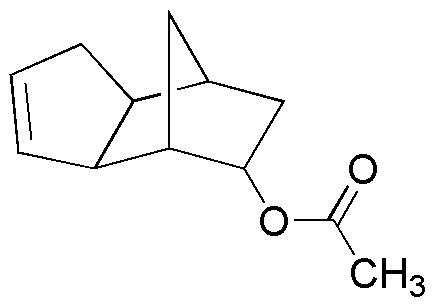3a,4,5,6,7,7a-Hexahydro-4,7-methanoinden-6-yl acetate is widely utilized in research focused on:
- Pharmaceutical Development: This compound serves as a key intermediate in synthesizing various pharmaceuticals, particularly in creating analgesics and anti-inflammatory drugs. Its unique structure allows for modifications that enhance therapeutic efficacy.
- Flavor and Fragrance Industry: Due to its pleasant aroma, it is used in the formulation of fragrances and flavoring agents, providing a natural scent profile that is appealing in consumer products.
- Polymer Science: The compound is explored in polymer chemistry for developing specialty polymers that exhibit unique mechanical properties, which can be beneficial in packaging and automotive applications.
- Biochemical Research: It is employed in studies related to enzyme activity and metabolic pathways, helping researchers understand biological processes and develop new biotechnological applications.
- Cosmetic Formulations: The compound is used in cosmetic products for its emollient properties, enhancing skin feel and stability in creams and lotions, making it a valuable ingredient in personal care formulations.
General Information
Properties
Safety and Regulations
Applications
3a,4,5,6,7,7a-Hexahydro-4,7-methanoinden-6-yl acetate is widely utilized in research focused on:
- Pharmaceutical Development: This compound serves as a key intermediate in synthesizing various pharmaceuticals, particularly in creating analgesics and anti-inflammatory drugs. Its unique structure allows for modifications that enhance therapeutic efficacy.
- Flavor and Fragrance Industry: Due to its pleasant aroma, it is used in the formulation of fragrances and flavoring agents, providing a natural scent profile that is appealing in consumer products.
- Polymer Science: The compound is explored in polymer chemistry for developing specialty polymers that exhibit unique mechanical properties, which can be beneficial in packaging and automotive applications.
- Biochemical Research: It is employed in studies related to enzyme activity and metabolic pathways, helping researchers understand biological processes and develop new biotechnological applications.
- Cosmetic Formulations: The compound is used in cosmetic products for its emollient properties, enhancing skin feel and stability in creams and lotions, making it a valuable ingredient in personal care formulations.
Documents
Safety Data Sheets (SDS)
The SDS provides comprehensive safety information on handling, storage, and disposal of the product.
Product Specification (PS)
The PS provides a comprehensive breakdown of the product’s properties, including chemical composition, physical state, purity, and storage requirements. It also details acceptable quality ranges and the product's intended applications.
Certificates of Analysis (COA)
Search for Certificates of Analysis (COA) by entering the products Lot Number. Lot and Batch Numbers can be found on a product’s label following the words ‘Lot’ or ‘Batch’.
*Catalog Number
*Lot Number
Certificates Of Origin (COO)
This COO confirms the country where the product was manufactured, and also details the materials and components used in it and whether it is derived from natural, synthetic, or other specific sources. This certificate may be required for customs, trade, and regulatory compliance.
*Catalog Number
*Lot Number
Safety Data Sheets (SDS)
The SDS provides comprehensive safety information on handling, storage, and disposal of the product.
DownloadProduct Specification (PS)
The PS provides a comprehensive breakdown of the product’s properties, including chemical composition, physical state, purity, and storage requirements. It also details acceptable quality ranges and the product's intended applications.
DownloadCertificates of Analysis (COA)
Search for Certificates of Analysis (COA) by entering the products Lot Number. Lot and Batch Numbers can be found on a product’s label following the words ‘Lot’ or ‘Batch’.
*Catalog Number
*Lot Number
Certificates Of Origin (COO)
This COO confirms the country where the product was manufactured, and also details the materials and components used in it and whether it is derived from natural, synthetic, or other specific sources. This certificate may be required for customs, trade, and regulatory compliance.


